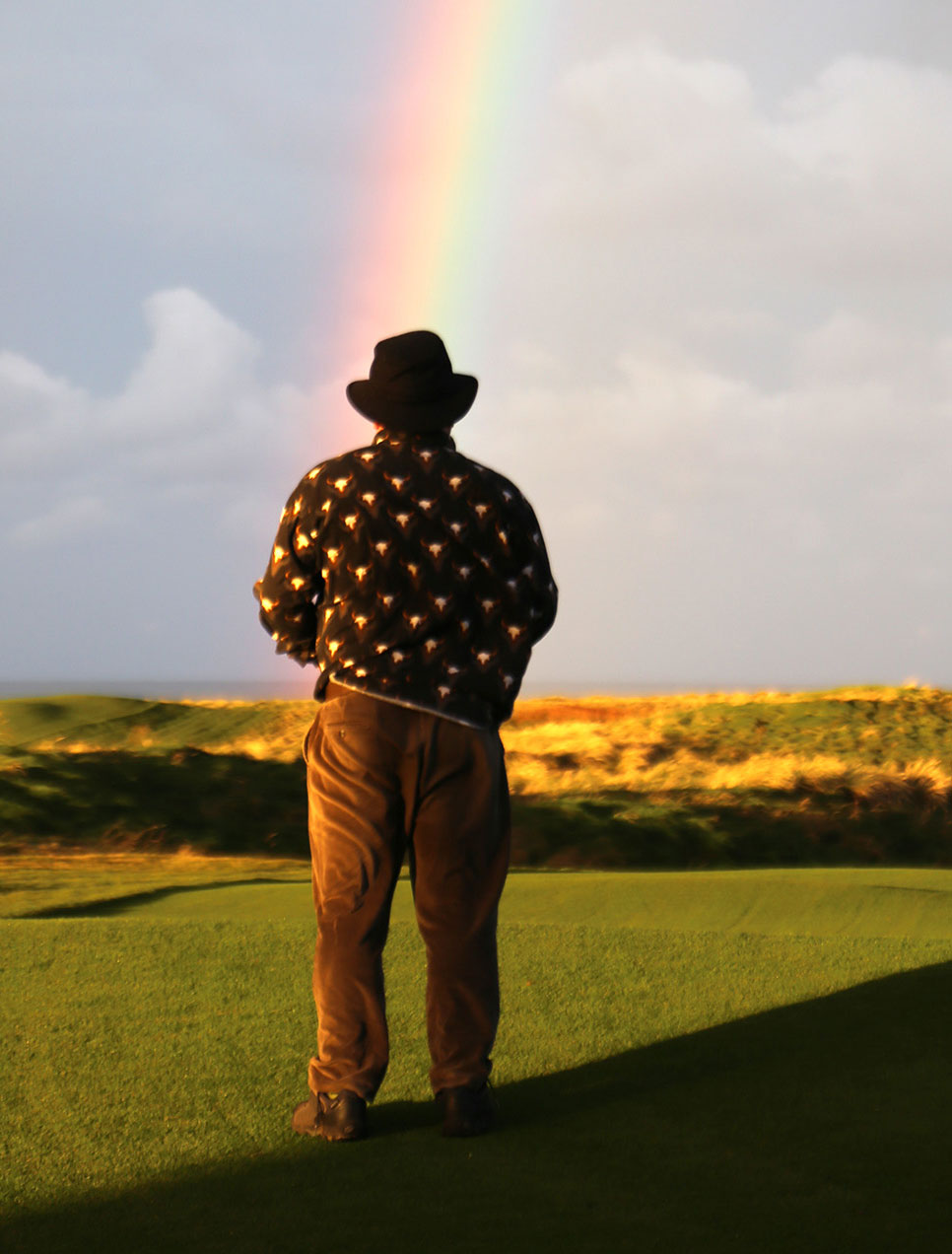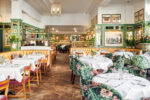Stanbrook Abbey Hotel – Review

By Kevin Pilley, November 2025
First George W. Bush stared at me. Then George Orwell. Followed by George Bernard Shaw, footballer George Best and Beatle, George Harrison. And then George Clooney. And finally, giggling, HRH Prince George Alexander Louis of the royal house of Windsor looked down at me.
I have never been stared at by so many Georges at the same time. But I suppose you should expect that in George’s Bar. What I didn’t expect was to go to the gents and, standing at the urinal, be laughed at by a group of nuns.
“This used to be a closed order,” said Graham, the barman at George’s Bar, Stanbrook Abbey in Callow End, between Worcester and Great Malvern — and therefore in the Malvern Hills of Worcestershire. “We must be the only hotel with photos of nuns in our loos.”
“Walk the cloisters”
Augustus Pugin designed the Palace of Westminster and is said to have gone mad thinking about Big Ben. His son Edward designed Stanbrook Abbey and its 40-metre-high bell tower with 240 stone steps. The carved choir stalls and confessional boxes came later.
Benedictine nuns used to walk the cloisters and grounds. Now it’s newlyweds and Groupon collectors. And Georges.
The original Stanbrook Hall, of which Bride’s Manor is the only part standing, was built for its owner, Richard Case, in 1755. It was bought by Cresacre More, descendant of the martyr Sir Thomas More, for the Second English Benedictine Congregation of Nuns, who lived austerely there from 1838 to 2009, when they relocated to Yorkshire.
“Revival of craftsmanship”
The More family crest, and those of the families of several prominent sisters, can be seen along the walls of the Thompson Dining Hall, which has morphed into “a unique dining and events space”. Its oak fittings in the former refectory were carved by Robert Thompson, “The Mouseman of Kilburn” (1876–1955), who left mice everywhere he worked.
Part of the 1920s revival of craftsmanship inspired by the Arts and Crafts Movement led by William Morris, Ruskin and Carlyle, he has a museum and company visitor centre in North Yorkshire. He inspired oak furniture makers like Thomas “Gnomeman” Whittaker, Derek “Lizardman” Slater, Colin “Beaverman” Almack, Wilf “Squirrelman” Hutchinson and Malcolm “Foxman” Pipes.
The Stanbrook nunnery is now a luxury country hotel and 26-acre estate. The abstinent lifestyle is hard to observe. Modern, lay self-indulgent luxuries include four-poster or king-size beds with the finest fibre pillows, shaving mirrors, vanity kits, heated towel rails, complimentary Fairtrade tea and en-suite hairdryer. If you want to withdraw from the world but still keep in contact with it, there is free Wi-Fi.
“Arched windows”
Self-denial only really arises with the desserts served, surrounded by huge arched windows, in Sister Charlotte’s Restaurant, where you are tempted with some very secular and bad-for-you sticky toffee pudding and almond frangipane, after rabbit roulade and duck or the no less earthly aubergine tian.
Of course, George’s Bar is the best place to nurse or cuddle a Benedictine.
The Callow Great Hall, the former church of the abbey, was consecrated in 1871. A lot of kneeling has left its mark on the uneven floors. The vaulted ceiling is transversely ribbed. Blond, highly polished Tasmanian yew has been used. The Nicholson organ, made in Malvern, still booms.
“Private annexe”
The east rose window was designed by John Hardman and depicts Our Lady of Consolation protecting Benedictine nuns. All the original floor tiles are from Minton, Stoke-on-Trent, who also supplied the flooring for the US Capitol building in Washington DC.
The small side chapel is called the Chapel of the Thorny Crown, as it once held a relic of the thorns from Glastonbury (Abbey). Allegedly, the head (Crown) of Christ was moved from Jerusalem to Byzantium and then to Venice and France. Holy thorns from the Ziziphus spina-christi plant are kept across Europe. About a hundred thorns remain.
The Bride’s Manor — the original 1755 Georgian manor house, then used as the presbytery — has been converted into a five-bedroom private annexe with parlour and fully equipped kitchen. The Groom’s Room, once the sacristy where the vestments were prepared for the visiting clergy, is now a piano room. Mother Superior’s spartan cell is now the Abbess Suite.
“Relaxing”
Stanbrook Abbey was also home to one of the oldest printing presses in England, established in 1876, and is the only known private press that was working from the nineteenth century into the twenty-first century. It was originally located in the approach to St Anne’s Hall, now home to a satellite kitchen and cloakroom facilities.
The church was deconsecrated in 2009. Major credit cards are accepted these days, rather than just vows of poverty and chastity. It has become a popular wedding venue. Although novices are still welcome.
Nunneries are relaxing places. But if you are in pursuit of redemption and salvation and wish to scourge yourself and engage in exercises of self-mortification, then you will be disappointed that the abbey has no spa, gym or fitness centre. But the bell tower provides a good aerobic step-up. And an escape from all the Georges.
Stanbrook abbey Hotel, Jennet Tree Lane, Callow End, Worcester, WR2 4TY
The Bollinger Edit is now available across select Hand Picked Hotels in the Channel Islands and mainland UK.
The Bollinger Escape comprises:
Two nights based on two people sharing, from £1,000.
A master suite or feature room for accommodation.
A complimentary bottle of La Grande Année 2015.
Elegant Bollinger gift box presentation.
A dinner menu including wine pairings personally selected by wine experts for each course.
Also available are the Bollinger Spa Experience and the Bollinger Afternoon Tea Experience.
handpickedhotels.co.uk/stanbrookabbey
FAQs – Stanbrook Abbey Hotel, Malvern Hills
What is Stanbrook Abbey Hotel?
A former Benedictine abbey turned luxury country hotel – set in twenty-six acres – with historic cloisters, a soaring bell tower and characterful spaces for dining and events.
Where is it?
Jennet Tree Lane, Callow End, Worcester, WR2 4TY – in the Malvern Hills of Worcestershire.
Who designed the abbey buildings?
The complex was designed by Edward Pugin, son of Augustus Pugin – the architect associated with the Palace of Westminster.
What is Bride’s Manor?
The original 1755 Georgian manor house – later a presbytery – now a five-bedroom private annexe with parlour and fully equipped kitchen.
Is there a spa or gym?
No – there is no spa, gym or fitness centre. Guests looking to stretch their legs can climb the bell tower and explore the extensive grounds.
Can guests climb the bell tower?
Yes – the tower rises around forty metres and rewards climbers with panoramic countryside views. Ask reception for a key card.
What dining options are on site?
The Refectory Restaurant serves a relaxed, seasonal menu; Sister Charlotte’s Restaurant offers desserts and dishes in a grand, arched-window setting; George’s Bar is ideal for light bites, pre-dinner drinks and nightcaps.
Is afternoon tea available?
Yes – afternoon tea is a house favourite. In fine weather, guests can dine alfresco on the terrace or take a picnic hamper into the grounds.
Are there private dining rooms?
Yes – spaces include The Clarence, The Wine Cellar, The East Room and other characterful rooms within “The Cellars”.
What is special about the Thompson Dining Hall?
Its oak fittings were carved by Robert “Mouseman” Thompson – part of the Arts and Crafts revival – and his trademark mice can be spotted in the woodwork.
What historic features can visitors see?
The Callow Great Hall (the former church) with a ribbed vaulted ceiling and Nicholson organ; a John Hardman east rose window; original Minton floor tiles.
Is there Wi-Fi?
Yes – complimentary Wi-Fi is available throughout the hotel for guests who wish to stay connected.
Is the hotel suitable for weddings and events?
Yes – the deconsecrated church and multiple period spaces make it a popular venue for weddings, celebrations and corporate events.
What is the Bollinger Edit/Escape?
A premium Hand Picked Hotels experience – typically two nights for two from £1,000 – including a master or feature suite, a bottle of La Grande Année 2015, a gift presentation and a dinner menu with paired wines. Bollinger Spa and Afternoon Tea experiences are also available.













